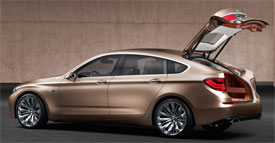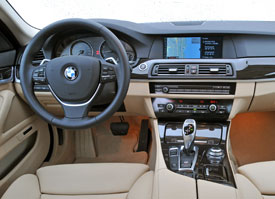2011 BMW 5-Series
With sporty moves and room for a family, BMW’s midsize 5-Series sports sedan has long been a segment benchmark and a MotorWeek favorite. But the all-new 2011 5-Series is something of a renaissance. While still packing a technology and powertrain wallop, it appears less aggressive and more executive. So let’s see if this really is progress.
Right off the mark, our visual take on the 6th generation 2011 BMW 5-Series is that it reminds us a lot more of the current flagship 7-Series than its direct predecessor. Yes, the twin kidney grille is naturally still there, but the previous 5’s Bangle-ized eyebrows are gone.
On the profile, the look is smoother but the character lines are more defined, all stretched over a 2-inch longer body, with a more telling, 3.2 inch longer wheelbase. The L-shaped LED taillights mimic the 7, while the rest of the toned down rear also looks more business than pleasure.
Top and bottom power are familiar. The 528i dons a three-liter straight six, rated at 240 horsepower, a bump up of 10. The 550i borrows the 7’s 4.4-liter twin-turbo 400 horsepower V8. Our 535i has the new powertrain, BMW’s latest 3-liter that trades two turbos for one twin-scroll unit. Output is unchanged, however, at 300 horsepower and 300 lb-ft of torque.
 A proper 6-speed manual is still standard on the six-cylinders, while optional with a six and standard on the V8 is BMW’s new gas saving eight-speed automatic.
A proper 6-speed manual is still standard on the six-cylinders, while optional with a six and standard on the V8 is BMW’s new gas saving eight-speed automatic.
Indeed, lots of Efficient Dynamics technologies have found their way into the 2011 5-Series, including regenerative brakes, electric power steering, and engine accessories that only produce engine drag when in use. Later in the year, x-Drive all-wheel drive will become available across the 5-Series lineup.
It didn’t take more than a few minutes at the track, however, to reassure ourselves that this more sedate looking 5 hasn’t dialed back performance one bit. Quick shifting our 535i’s manual delivers 0 to 60 in an impressive, and quite quiet, six seconds flat. The quarter mile mark came up in 14.5 seconds at 98 miles per hour. Both numbers getting close to the 5-Series GT V8 we tested last spring.
Just as laudable was our average 60 to 0 stopping distance of a very short 116 feet. The pedal wasn’t the firmest, but feedback was good, and fade nonexistent, from the all-wheel vented disc brakes.
Still, our handling test would be the big hurdle, an area where the previous 5-Series was a champion. Turn-ins are still quick, even if the electric power steering is a little numb. More curb weight means slightly more body roll, even in stiffer sport mode, but there’ s still little lack of poise, thanks to a new multi-link front suspension. So, when all was said and done, we were very happy.
I didn’t want to like the new 2011 BMW 5-Series. It got bigger, more luxurious, and less like the cars that I’ve always loved. Or so I thought. Sitting behind the wheel, it does feel like a 7-Series, and out on the highway it’s so smooth and quiet. But on back roads when you turn that wheel, well, everything I’ve always loved about a BMW sports sedan is front and center. My conclusion the new 5-Series is a great car.
 Inside, the new 5’s interior also takes on the 7’s more luxurious appeal. Our 535i came dressed to really impress with optional wood trim. BMW’s sensible, classy, horizontal architecture now has well-integrated 21st-century touches like adaptive cruise control and a lane departure warning system.
Inside, the new 5’s interior also takes on the 7’s more luxurious appeal. Our 535i came dressed to really impress with optional wood trim. BMW’s sensible, classy, horizontal architecture now has well-integrated 21st-century touches like adaptive cruise control and a lane departure warning system.
The fourth generation of iDrive appears either on a seven-inch screen recessed atop the now canted center stack, or with optional navigation on a larger 10.2-inch screen.
Rear seat knee room improves very slightly, while comfort is still above par for second-row passengers. 40/60 split-fold functionality is optional, as is a center pass-through.
In Government Fuel Economy Ratings, our manual 535i is rated at a decently frugal 19 miles per gallon city/28 highway. We managed an average of 22.3 miles per gallon on premium gas. On sale now, the 528i starts at $45,425. Our 535i begins at $50,475, and the 550i has a base sticker of $60,575.
With equal parts thrill and finesse, BMW has clearly taken the right path with this thoroughly modern car. Moreover, the 2011 BMW 5-Series remains one slick-shifting, fine-driving, midsize German sports sedan icon.
Specifications
- Engine: 3-Liter Turbo
- Horsepower: 300
- Torque: 300 Lb Feet
- 0-60 MPH: 6.0 Seconds
- 1/4 Mile: 14.5 Seconds @ 98 MPH
- 60-0 MPH: 116 Feet
- EPA: 19 MPG City/ 28 MPG Highway
- Mixed Loop: 22.3 MPG
2024 Polestar 2
More Range And More Power For The Polestar 2
Volvo is well on their way to making the transition to an all-electric brand, but their sister-brand Polestar is already there. Now, we’ve spent lots of time in their all-wheel drive, five-door Polestar 2, having tested it in 2021, and a year later when a two-wheel drive version arrived. But, EV updates are coming quickly. So, let us be your guide for all that’s new with the Polestar 2.
While we are driving more EVs than ever, we’ve also been spending a lot of time recently circling back to ones we’ve previously tested. As in this new era of electrified vehicles, significant updates are arriving quickly, with R&D investments increasing and retrofitting them easier than ever. This is often done through software updates that can even be accomplished over the air. For 2024, the Polestar 2 has indeed gotten some software updates, but some physical ones as well.
Clearly aimed directly at Tesla’s Model 3 when it arrived; the Polestar 2’s build quality was vastly better, but range definitely came up short. So, addressing that was priority No. 1; and for ’24 the Polestar can travel up to 20% farther than before while consuming 9% less energy, and when it comes time to charge it back up, it can do that 34% faster too.
Range in the Single Motor version increases from a max of 270 to 320 miles thanks to a larger 82-kWh battery pack, and that solitary motor now powers the rear wheels, not the front wheels. It’s also bigger, coming in at 220 kW compared to the previous 170 kW front-wheel drive version, going from 231 to 299 horsepower.
Dual Motors keep the same 78-kWh battery, but still sees a boost from 260 to 276 miles and takes advantage of the larger rear motor for a new combined 310-kW output with 421 horsepower. Our test car has the added Performance Pack, which uses an additional 35 kW to deliver 455 horsepower and 546 lb-ft of torque, though max range drops to just 247 miles.
The new battery in rear-drive 2s will also charge faster, now accepting up to 205 kW for an 80% charge in 20 minutes; max for dual-motors stays at 155 kW, which puts an 80% charge at 34 minutes. Using 32 kWh of electricity per 100 miles, the Dual Motor earns a good efficiency rating.
The [Polestar] 2 has always been one of the most enjoyable EVs to drive, even more so now with that additional power coming from the rear motor.
Unfortunately, extremely cold temperatures kept us from seeing that increased range, as we were only on pace for about 194 miles in our test.
The 2 has always been one of the most enjoyable EVs to drive, even more so now with that additional power coming from the rear motor. And especially when equipped with the Performance Pack as it not only includes more power, but adds 20-inch forged wheels, upgraded brakes, and adjustable Ohlins Dual Flow Valve performance dampers. It greatly improves handling prowess without affecting ride quality, and is easily worth the $5,500 charge if you at all enjoy driving.
Even on a 20-degree track day there was plenty of grip through our handling course. No understeer or oversteer, and lots of feedback through the wheel. There was a nice, strong launch off the line that properly planted us firmly in the seat, and rocketed us to 60 in 4.5 seconds. Power delivery stayed pretty intense up until about 80 mph when there was a definite tapering off. Still, it was a 13.4-second quarter-mile at 102 mph; smooth, quiet, and stable the whole way.
When this car debuted, its Google-based infotainment setup was a novelty, but since then, more and more manufacturers are just “Googling it” so it doesn’t seem out of place at all. The wireless phone charger is easy to access, and there’s a great Harmon/Kardon sound system and panoramic sunroof to enhance the in-cabin experience. Exteriors have also been enhanced with a smooth grille insert and new wheel choices.
Hatchback practicality means 14.3 cu-ft of easy to access cargo space with split-folding seatbacks for longer items and expanding the space to 38.7 cu-ft. Plus, there’s even a sizeable storage bin up front under the hood.
Single Motor Polestar 2 pricing now starts at $51,300, with Dual Motors starting at $56,700; topping out at $64,400.
For a car manufacturer that hasn’t even been around for a decade yet, Polestar has kept itself busy, totally transforming their latest model in just a few years, making the 2024 Polestar 2 even more appealing. They are certainly off to a good start, and with a host of Polestars just over the horizon, including some all-important utility vehicles, this star will be shining even brighter.
Specifications
As Tested
- Motor Setup: Dual Motor
- Horsepower: 455
- 0-60 mph: 4.5 seconds
- EPA Range: 247 miles
- Efficiency : 32 kWh / 100 miles
- Battery Size: 78-kWh
- Torque: 546 lb-ft
- 1/4 Mile: 13.4 seconds at 102 mph
- MW Test Loop: ~ 194 miles
- Peak Charging Rate: 155 kW











































